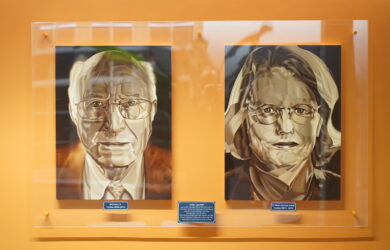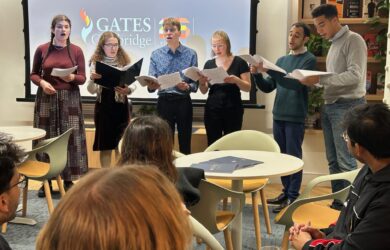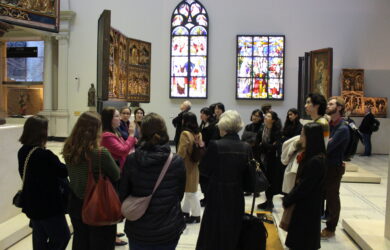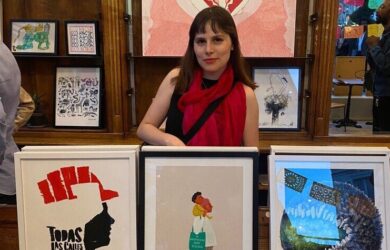Luke Edelman's research takes a biotechnological approach to finding out what makes certain genes turn on or off.
What makes specific genes turn on in some cells and not in others? Finding the answer could lead to the development of new treatments which could revolutionise medicine. Luke Edelman’s research takes a biotechnological approach to the issue, looking at the mechanics of how cells organise their genetic information in three dimensions.
With an undergraduate degree in bioengineering, he began his PhD in Biological Science at the Babraham Institute in Cambridge in 2009 under the molecular biologist Peter Fraser.
His group studies ‘epigenetics’, examining the role played by molecules known as ‘Noncoding RNA’ in the control of developmental processes and human disease. He says: “You can imagine that DNA is sort of like organised molecular spaghetti. Different parts of the spaghetti correspond to different genes that cooperate with each other in actually quite precise ways, functioning as a structured and regulated molecular machine. We examine how cells switch genes on and off by controlling this three-dimensional structuring.
“My project involves developing experimental and computational methods to analyse the roles played by RNA, a chemical cousin of DNA, in controlling these shapes. We create mathematical frameworks to assess the three dimensional shape of DNA organised inside a cell, and then integrate information about how RNA affects this structure and the activation of genes.”
Luke’s interest in bringing together technology and medicine began at an early age. He grew up in a medical family in the Chicago suburb of Glenview. His mother studied biology and his father was an anaesthetist who was interested in medical technology. The family used to talk about the latest medical research and technology around the dinner table. Luke would also visit hospital operating theatres with his father on ‘take your child to work’ days.
It was these early experiences that he feels were partly responsible for his decision to do a degree in bioengineering at the University of Illinois. “The degree was half biology and half maths and physics. I was interested to look at biological things from an engineering perspective,” he says.
Luke [2009] applied to the University of Illinois because it was one of the few universities to offer a programme in bioengineering. “It was still early days for the bioengineering field at the time,” he says. He was also the third generation in his family to attend the university. The course took four years and covered areas including genetics, physiology, engineering and maths.
Lab work
During his time at the University Luke worked at two different research laboratories. One was an anaesthesia laboratory and his work there was pivotal to his subsequent interest in the possibilities of biological science and medicine.
He worked on a project looking at ways to treat heart attack patients whose attack was caused biochemically, for instance through poisoning by anaesthesia drugs. “During some simple surgical procedures, problems can occasionally develop in which local anaesthetic drugs accidentally enter the bloodstream. If they reach the heart they can cut off its energy supply. It’s a rare event, but this problem was essentially untreatable. It was a molecular issue and CPR chest compressions didn’t help,” says Luke.
The lead researcher Professor Guy Weinberg found that if globules of fat were injected into the blood they would suck all the poisonous chemicals into the fat and so the patient’s heart would start to beat again. “He discovered this by accident. He thought injecting fat globules would probably make things worse, but he found that it was an almost instantaneous treatment. I was working with him to discover why it was effective and how it affected the molecular systems in the heart,” says Luke.
He adds that, although he has drifted since to other areas of research, this project was “the most significant and meaningful point in my career”. “It was really interesting science and I saw cases where the procedure was done and saved the patient’s life. That was a turning point for me,” he says.
Gene activity
The second laboratory project he worked on was with Nathan Price in the area of systems biology, studying how gene activity can be used to diagnose disease. “We employed a technique to measure how active many thousands of individual genes were. My project was to apply this information to develop novel diagnostic techniques. This could allow researchers to assess, for instance, from looking at a bit of biopsy tissue that might be cancerous, whether it was benign or potentially more malignant. I developed a computational framework so we could do this in a wide range of clinical settings.”
“We were looking at it from an engineering perspective. We defined a discrete list of biological parts and assessed how they worked together as if they were components of a machine – using computational techniques to resolve a biological problem,” he says.
Luke found the laboratory atmosphere exciting and motivating. He applied to Cambridge to do his PhD in Biological Science. It was a switch of fields and a move away from engineering, which presented its own challenges but allows him to keep a foot in both the medical and engineering fields.
Luke is keen to continue to straddle these two worlds when he finishes his PhD and hopes to apply his experience in biotechnology to specific medical problems in the future.












